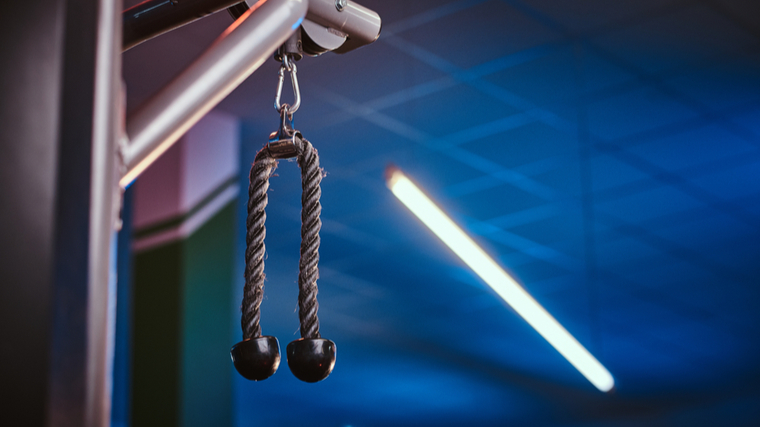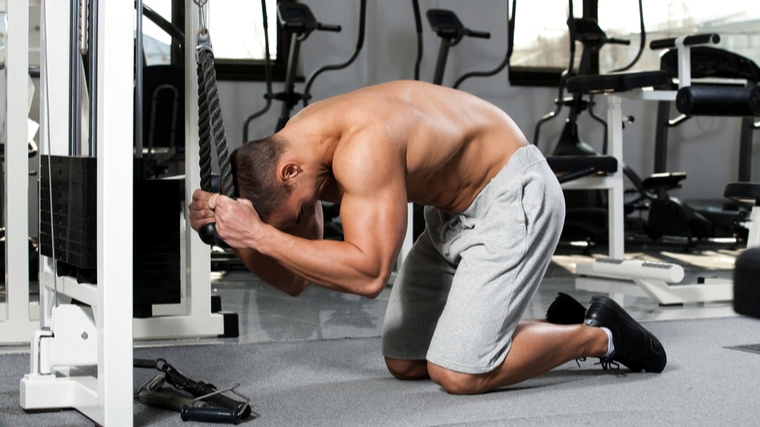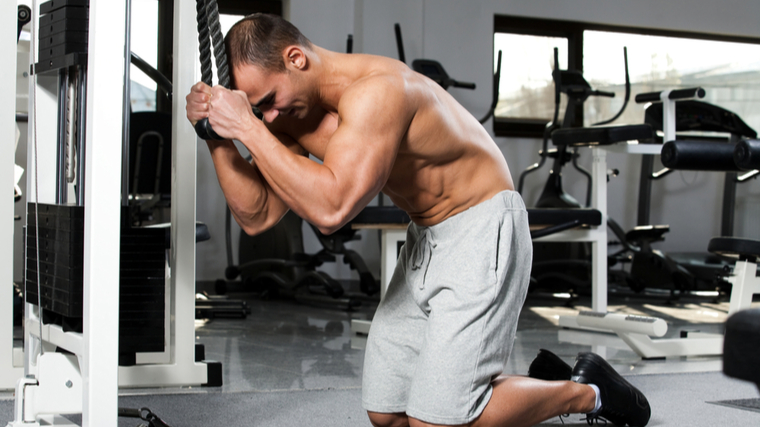When you want to pull a heavier deadlift or squat three plates, you need a strong core to support all that stress on your torso. And if one of your goals has always been developing a midsection that pops, you’ll also want to focus on integrating core-specific training into your program.
Your core will get a great workout in the course of training your heavy barbell lifts, but you’ll need to get a little more specific to really maximize those ab gains. And if you want a visible set of abs, you’ve got to achieve an overall reduction in body fat levels. However, your abs are still a muscle — so if you really want them to get strong and visible, you’ve got to train them up.
As with any muscle, you can enhance your ab’s size and shape through hypertrophy-based training. The cable crunch is one of the best tools for the job. It’s weighted, controlled, and well-suited to helping your six-pack muscles get stronger and bigger. Here’s everything you need to know about the cable crunch to build yourself a set of bricked-up abs that can support the heaviest of compound lifts.
- How to Do the Cable Crunch
- Cable Crunch Sets and Reps
- Common Cable Crunch Mistakes
- Cable Crunch Variations
- Cable Crunch Alternatives
- Muscles Worked by the Cable Crunch
- Benefits of the Cable Crunch
- Who Should Do the Cable Crunch
- Frequently Asked Questions
How to Do the Cable Crunch
The cable crunch is best performed using a triceps extension rope handle. You’ll be able to secure yourself to the resistance from the cable stack by holding one end of the rope in each hand and setting it across your upper back.
Step 1 – Set Up

Using the triceps extension rope attachment, secure each hand at the base (usually there is a knot or hard plastic end piece). With the rope in your hands, lay the attachment across your traps. Hold it in your hands as though you were at the top of a hammer curl. Kneel down and set your stance about hip to shoulder-width apart. You can face toward or away from the machine, depending on your preference.
Step 2 – Crunch

Begin your crunch by bracing your core. Flex your quads, glutes, and core. Squeeze the rope attachment in your hands. While breathing out all of your air, contract your abdominals and curl your torso towards the ground. The goal is to curl your spine as much as you can.
Step 3 – Reset

Maintain your brace as much as possible to prevent big changes in your hip positioning throughout the reset. Slowly straighten your torso back to the starting position. Maintain tension on your abs the entire time.
Cable Crunch Sets and Reps
Yes, moves like squats and deadlifts put some serious strength-building demands on your core. But the cable crunch is a powerful way to sprinkle some core-specific training into your program. Depending on your goals, your set and rep scheme will look a bit different.
- For Muscle Mass: Perform three to four sets of 10 to 12 reps, using a moderate but challenging load.
- For Strength: Do two to three sets of eight to 10 reps, using a moderately heavy load.
- For Endurance: Aim for three to four sets of 15 to 20 reps, using a load on the moderate but slightly lighter side.
Common Cable Crunch Mistakes
There is a reason that the cable crunch is routinely passed over for more functional core training — think suitcase carries — or even machine-based abdominal exercises. But if you are choosing this spectacular ab move, it’s important to make sure you’re doing it right. Some mistakes to avoid are going too heavy, going too light, and using far too much body English.
Going Too Heavy
It might be tempting to load up on this lift. But one way to minimize the work your abdominals are doing is by recruiting way too much of everything else. One common mistake is going too heavy too early. Forcing yourself through the range of motion is not the same thing as using mainly one muscle to do so. Keep the load manageable so that you can primarily use your abdominals to move. Otherwise, you’ll risk underloading your abs and overloading your traps, arms, and back instead.
Going Too Light
The complete opposite is also a common error when performing the cable crunch. You can undercut the value of the exercise completely if you go far too light to achieve any real stimulus for the abs. To make matters worse, you might not even know you’re not getting the muscle-building results you’re looking for until cutting season reveals your underwhelming progress. Keep things loaded appropriately to hit near-failure within the repetition ranges you need.
Too Much Body English
One of the consequences of going too heavy is often increased body English, or breaking form to use momentum to complete your reps. While there is a time and a place to cheat your form to help you eke out a few more muscle-building reps, this might not be the best move for that. Shoving yourself forward with momentum to complete your reps may take tension off of your abdominals completely. This could render the exercise hugely ineffective because your abdominals do so little of the actual work. Keep things strict for the best gains with this exercise.
Cable Crunch Variations
You can strategically deploy a few subtle variations on the cable crunch to dial in your training even more. Changing your position from standing to kneeling or facing towards or away from the machine are simple ways to modify your core work. You can also combine these as needed to best serve your goals.
Standing Cable Crunch
The standing variation of the cable crunch changes the most challenging aspects of the exercise in two ways. By standing, you’re going to have to stabilize a much longer lever (your entire body) while performing each repetition.
[Read More: The Most Effective Workout Splits, Created by Our Experts]
The rope attachment — AKA, your source of resistance — will be so high up from the ground compared to the kneeling version. As a result, you’ll need a lot more core engagement to simply not lose position. Another major benefit of the standing cable crunch is that it makes this move more accessible to athletes whose body types might not be conducive to kneeling variations.
Facing Towards Cable Crunch
Facing toward the machine will make the initiation of each repetition feel a bit easier. Because the resistance path of the cable won’t be trying to pull you backwards, you’ll be able to more easily crunch straight down.
This means that you’ll be able to move more weight when you’re facing the cable stack. Make sure you’re still controlling each rep and performing less reps in accordance with your higher load.
Facing Away Cable Crunch
Facing away from the machine will make the initiation of each repetition harder. That’s because you’ll have to overcome the cable machine trying to pull you out of position from the very set up of the move.
You’ll be working to stabilize your body even before your abs can really dial in the horsepower to curl your torso down. Because you’ll use less load with this variation, it’s more useful for higher rep counts when you’re looking to build endurance.
Cable Crunch Alternatives
There are few tried-and-true alternatives to the cable crunch if you’re unable to find the right station. The machine crunch and the old trusty bodyweight crunch are two of the best alternatives out there.
Machine Crunch
The machine crunch is available in most commercial gyms. You’ll adjust the machine’s settings to fit your body proportions and select the proper resistance with the pins.
Performing a crunch with a machine allows you to be seated — instead of lying down — and your movement path will be externally stabilized by the machine itself. This allows you to strictly focus on curling your spine by using your abdominal muscles.
Bodyweight Crunch
The bodyweight crunch requires a bit more skill to properly execute than the machine crunch. To perform a crunch properly, you’ll have to stabilize your body’s movements without relying either on your hip flexors or yanking your neck to do the work for you.
While lying on the floor or on a physioball, curl your spine (think: chin to knees) by contracting your abdominals. Make sure the contraction is coming from your abs rather than using momentum from elsewhere.
Muscles Worked by the Cable Crunch
As an isolation exercise, the cable crunch is a fairly straightforward ab movement. Yes, you’ll need your arms and traps to hold and support the weight in place, but they by no means should be involved in the actual movement.
Rectus Abdominis
The primary muscle worked by the cable crunch will be your rectus abdominis. This is your six-pack muscle, located smack dab in the middle of your torso. Its primary job is to flex your spine, so the cable crunch makes a lot of sense when you want to target this muscle group.
Benefits of the Cable Crunch
While you might just be looking to build up your core muscles and strength, you might be surprised by the ability of the cable crunch to connect yourself to your body awareness, too.
Proprioception
Though it may not be the first cable crunch benefit that springs to your mind, you actually need a great deal of proprioception to perform a solid cable crunch. Knowing where each joint is relative to each other — think: your shoulders, hips, and spine — while you perform each repetition is important to guarantee the right muscles are actually working. You’ll learn how to keep track of your body’s alignment and how each joint impacts the others through higher rep sets of this move.
Baseline Core Strength
Heavy compound lifts and core-based exercises are the bread and butter of improving core strength. But still, a heavy cable crunch is nothing to scoff at. The amount of physical bracing you’ll need to use to properly perform the cable crunch will definitely help develop universally-applicable core strength.
Aesthetics
The cable crunch effectively isolates and trains your rectus abdominis muscle — which is what you’re likely thinking about when you fantasize about bodybuilder-level abs. Although endless cable crunches will not spur spot fat reduction and “burn” fat from your abs directly, training them directly won’t hurt to improve the overall six-pack vibe of your abs once they are uncovered.
Who Should Do the Cable Crunch
Regardless of experience level, you should probably be doing the cable crunch to help you strengthen and eventually show off your front torso.
Bodybuilders
Bodybuilders have a vested interest in developing their muscles to the greatest extent possible. Lifting heavy with compound movements is an essential component to getting big and strong — but isolation movements are also extremely important for bodybuilders. Because the cable crunch isolates your rectus abdominis so effectively, you’ll want it as part of your program if you’re a bodybuilder.
Strength Athletes
Strong abs aren’t just valuable for bodybuilders. Strength athletes like powerlifters and weightlifters also need powerful abs to support their big barbell moves. Since strength athletes build their programs around heavy compound lifts, it’s easy to forget to incorporate core-specific work. But neglecting ab work might leave precious poundage on the table when you’re trying to up those one-rep maxes. Focusing on your abs with moves like the cable crunch can give your core the boost it needs to better support stronger barbell lifts.
Recreational Athletes
If you love lifting, you probably want a strong core to support your recreational endeavors. The cable crunch does require locked-in form, but it’s not overly complicated to learn. You can also do standing variations to accommodate different body types and training needs.
Wrap-Up
To build muscle effectively, you’re going to want to contract a muscle as strongly and specifically as possible. You’re in luck with the cable crunch — it allows all that juicy musculature that you see in six-pack abs to contract as a coordinated unit, leaving you with a great core workout and muscle-building potential. With a more muscular, stronger core, you can also help yourself load more plates onto the barbell for an all-around improvement to your lifting game.
FAQs
Still got questions about how to make the cable crunch part of your routine? No problem. We’ve got answers.
How often should I perform the cable crunch?
The abdominal muscles are highly resilient, but they also need time to recover. To that end, you likely should perform the cable crunch no more often than every other day. Your abdominals are involved in nearly every exercise to some extent, so keep that in mind before you start performing the cable crunch every day.
What should I use if I don’t have a rope attachment?
In a pinch, a straight-bar triceps pushdown handle can be used. That said, you will potentially need more shoulder and wrist mobility to hold the position, which could make the move less accessible to many lifters. Another great option is to find a pair of long length D-handles. Holding one per hand is a solid solution here.
Is the cable crunch safe?
Spinal flexion is often regarded as unsafe during exercise — but the cable crunch is an intentional movement where your spine itself is not directly under load. Flexing and extending your spine during direct abdominal work is generally safer without a barbell or dumbbell loading your spine.
Featured Image: Skydive Erick / Shutterstock